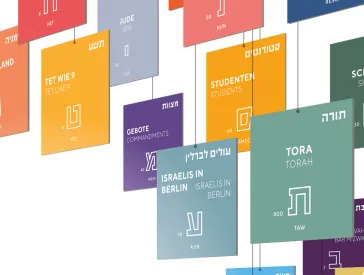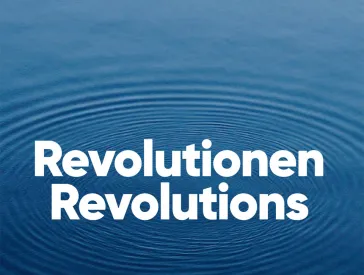What happens when an exhibition comes about with the participation of many?
Working on the exhibition A Is for Jewish
Léontine Meijer-van Mensch, Miriam Goldmann, Christiane Lindner, and Fabian Schnedler
The exhibition A Is for Jewish: Journeys through Now in 22 Letters came about with the participation of many people. For in order to show the diversity of Jewish identities and everyday realities in Germany, there has to be a voice for the people who actually make up the present.
What happens when the Program Director, exhibition curators, colleagues from the education department, and the artists’ collective SIDEviews sit down together to think about an exhibition? The outcome, A Is for Jewish: Journeys through Now in 22 Letters, can be experienced from November 2018 in the Eric F. Ross Gallery of the Jewish Museum Berlin.
The path to the finished exhibition was not always smooth, with many plot developments on the way. At one point, a revolt threatened to erupt, and in fact our work probably was a little revolutionary now and again—after all, we were trying to upset the classic division of roles within the museum. Trying out new methods and multiplying the number of voices is not necessarily easy, especially in a large museum. It demands an open mind, tolerance, and a willingness to engage with different methodological toolboxes. That’s hard work, but it’s also an integral part of modern museum approaches.
For all of us, it was important to integrate educational aspects into the curatorial process from the outset. The exhibition was intended to interest younger visitors, though not only them. Participation is an effective method for museums to achieve that goal, as is evident in many local museums and ethnographic museums.
In April 2017, a cooperative project with the artists’ collective SIDEviews generated the idea of developing an exhibition with the participation of young people. Students from the Refik Veseli School in the Kreuzberg district of Berlin had already explored the Jewish Museum as part of the project “VOIDS.MuseumVerLernen” (VOIDS.MuseumUnLearn), suggesting how to make a museum attractive and relevant for youngsters. Their ideas and reflections flowed into our exhibition and can be seen in the form of an artistic video commentary.
“Who’s speaking about whom here?” That question is particularly pressing for an exhibition about the present day, where there is a special risk of repeating stereotypes or presenting one-sided perspectives. Apart from the voices of the museum personnel and the commentaries of the young people, the exhibition therefore also—and primarily—gives a say to the people who actually make up the Jewish present.
Postcard for the Festival Disintegration. A Congress of Contemporary Jewish Positions at the Maxim Gorki Theatre in May 2016; idea: Max Czollek, Sasha Marianna; design: Deniz Keskin
That includes the young Israelis who left their home country for all sorts of reasons and are now building a new life in Germany, especially in Berlin, as well as the families of refugees who left the Soviet Union mainly in the 1990s under the quota system and contributed to a radical transformation of Germany’s Jewish communities. It also includes artistic positions such as the “Desintegration” (Disintegration) initiative at the Maxim Gorki Theatre, in which young Jews try to redefine their relationship with Germany. They refuse to be defined solely by the coordinates of Shoah, antisemitism, and Israel. Their provocative statements force both Jewish and non-Jewish visitors to reflect on habitual, ingrained ideas.
A Is for Jewish presents the diversity of Jewish identities and everyday realities in Germany. In the exhibition, the twenty-two letters of the Hebrew alphabet draw attention to present-day Jewish positions. Twenty-two spotlights describe everyday life as it is lived by Jews both secular and religious, newly arrived and long established in Germany: from music and memory cultures (via traditions, linguistic diversity, and youth culture) to artistic interventions. The objective is to portray Jewish life from the turn of the twenty-first century onward—18 years of the present, experienced in all its multiplicity and contradictions.
During the exhibition’s run, we will also include a performance stage for the young participants, and a space for the Jewish present day in Germany to be debated as part of our accompanying program.
A Is for Jewish offers a multiplicity of voices, food for thought, plenty of fun, a little irony, perhaps occasionally a more reflective moment. And what about the young people? They asked for a chill-out corner with a sofa as a place for their questions, an open space for conversation and discussions. For a museum, that itself may be a revolution.
This article was first published in 2018 in issue 19 of the print edition of the JMB Journal.
Citation recommendation:
Léontine Meijer-van Mensch, Miriam Goldmann, Christiane Lindner, Fabian Schnedler (2018), What happens when an exhibition comes about with the participation of many?. Working on the exhibition A Is for Jewish.
URL: www.jmberlin.de/en/node/5921


